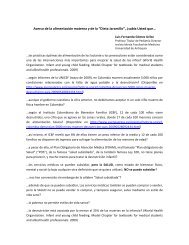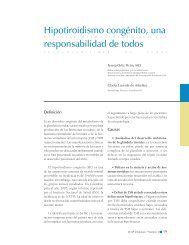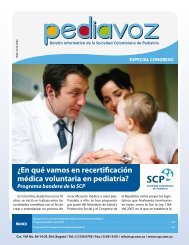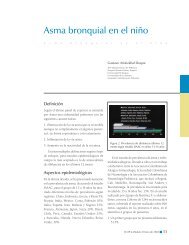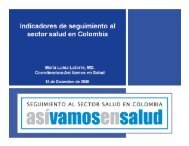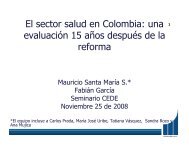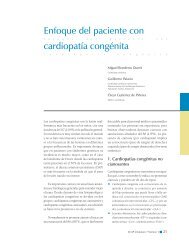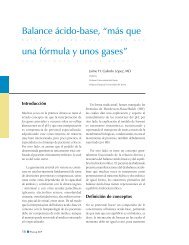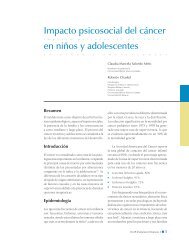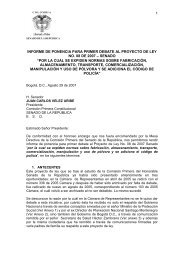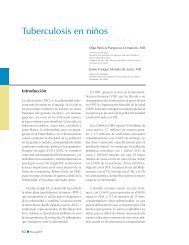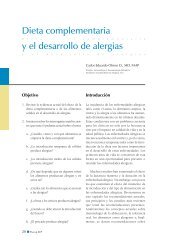Descargar - Sociedad Colombiana de Pediatria
Descargar - Sociedad Colombiana de Pediatria
Descargar - Sociedad Colombiana de Pediatria
Create successful ePaper yourself
Turn your PDF publications into a flip-book with our unique Google optimized e-Paper software.
72 :: Confiabilidad diagnóstica <strong>de</strong>l reporte materno <strong>de</strong> fiebreMethods: A study to assess a diagnostic test against a gold standard was conducted in 469 children aged zeromonths to 15 years seen due to fever in the emergency rooms of two pediatric hospitals in Bogotá, Colombia. Dataabout use of thermometer and medications or other measures to treat fever, as well as the mothers’ <strong>de</strong>finition offever, were obtained using a standardized questionnaire. Mothers were requested to establish subjectively whethertheir children had fever before measuring the body temperature. Their diagnostic accuracy was evaluated usingthe physician’s reading of the child’s temperature as standard. Mothers of the last 142 patients were also asked toread the glass thermometer immediately before the physician’s measurement.Results: Three-hundred-nine mothers (65,9%) reported to have used a thermometer at home. Thirteen percent and56, 3% of mothers recognized to ignore the <strong>de</strong>finition of fever or provi<strong>de</strong>d incorrect values, respectively. Most mothers(87,8%) used palpation to <strong>de</strong>termine the presence of fever. The sensitivity and specificity of mothers´ subjectiveperception were 0,80 (95%CI, 0,75 to 0,84) and 0,63% (95%CI, 0,55 to 0,71), respectively. The intraclass correlationcoefficient for concordance between the mothers’ and the physician’s thermometer readings was 0,75.Conclusions: Mothers’ subjective reports of fever have a<strong>de</strong>quate diagnostic accuracy. Even though an importantproportion of mothers in Bogotá seems to use thermometers, a significant fraction of them do not know the temperaturevalue that indicates fever.Key words:Fever; Sensitivity and specificity; Parents; Thermometer; Intraclass correlation coefficient.INTRODUCCIÓNLa fiebre es una manifestación común en ungran número <strong>de</strong> enfermeda<strong>de</strong>s, principalmente<strong>de</strong> carácter infeccioso, y, por ello, constituyeuno <strong>de</strong> los motivos <strong>de</strong> consulta más frecuentespara los pediatras 1 . Sin embargo, en muchasocasiones el médico tratante solo cuenta conel reporte materno <strong>de</strong> una percepción subjetiva<strong>de</strong> fiebre, no confirmada por la toma <strong>de</strong> latemperatura corporal mediante termómetro. Enestas circunstancias pue<strong>de</strong>n presentarse dudasrespecto a la verda<strong>de</strong>ra presencia <strong>de</strong> fiebre enel paciente. Algunos estudios conducidos enEstados Unidos, India y África han tratado <strong>de</strong>establecer la confiabilidad <strong>de</strong> la <strong>de</strong>terminaciónsubjetiva <strong>de</strong> fiebre por parte <strong>de</strong> la madre 2-7 . Hastadon<strong>de</strong> llega nuestro conocimiento no hay reportessimilares provenientes <strong>de</strong> América Latina.La generalización <strong>de</strong> los resultados publicadosen torno a nuestro medio pue<strong>de</strong> ser difícil almenos por dos factores: 1. La mayor parte <strong>de</strong>estos trabajos se realizaron en zonas endémicaspara malaria; es posible que las madres <strong>de</strong> niñosresi<strong>de</strong>ntes en estas áreas, don<strong>de</strong> la malaria y, portanto, la fiebre son comunes, puedan reconocerel síntoma más fácilmente que las resi<strong>de</strong>ntes enzonas don<strong>de</strong> la malaria es menos frecuente; y 2.Existen en nuestro medio conceptos culturalessobre la fiebre que nos son particulares, como lapresencia <strong>de</strong> la llamada “fiebre interna”.El objetivo principal <strong>de</strong> este estudiofue establecer la confiabilidad diagnóstica <strong>de</strong>la <strong>de</strong>terminación subjetiva <strong>de</strong> la presencia <strong>de</strong>fiebre por parte <strong>de</strong> la madre. En segundo lugar,se quiso <strong>de</strong>terminar la frecuencia con la que lasmadres en nuestro medio emplean el termómetropara confirmar la presencia <strong>de</strong> este síntoma, suconocimiento respecto al punto <strong>de</strong> corte <strong>de</strong> latemperatura que <strong>de</strong>fine fiebre, y la concordanciaentre el médico y la madre al leer la temperaturausando un termómetro <strong>de</strong> mercurio.MATERIALES Y MÉTODOSEste estudio se llevó a cabo en las consultas <strong>de</strong>urgencias <strong>de</strong> las clínicas <strong>de</strong> Cafam y Colsubsidio,centros <strong>de</strong> atención terciaria <strong>de</strong> Bogotáque también brindan atención primaria a nivel<strong>de</strong> consulta externa, y que al momento <strong>de</strong> laPEDIATRÍA - VOL 41 No. 2 - 2006



